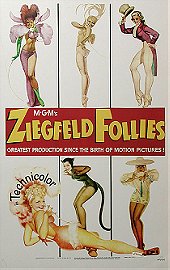In the end it’s a bit of a bloated mess, going beyond peaks and valleys and winding up as something far more unstable. Ziegfeld Follies is consistently entertaining, and when it’s good it’s great, but the rough patches are half-formed segments which exist seemingly to just showcase more of MGM’s large wealth of talent without crafting something interesting for them to do. Thankfully the film is smart enough to be nothing more than a filmed revue and doesn’t bother with a plot.
Well, except for the introduction that has William Powell reprise his role as Ziegfeld in an opening segment glorifying his years as an entertainment maestro while he looks down from heaven. Ziegfeld takes a moment to mourn the loss of the type of entertainments that he trademarked in, and we’re then treated to a series of stop-motion recreations of some of the most famous shows and stars of the follies. While mostly cute and harmless, until a few of the puppets are placed into black face or act out questionable material for a modern audience, this opening segment is also a hint of the film’s back-patting while also applauding itself. Only MGM would imagine a scenario in which the great entertainment czars of the past get their own separate heavenly ideal.
But it’s not all bad or questionable. When Follies gets into a groove it delivers everything you could possibly want from a self-contained segment. The introductory one is quite insane, a piece of high-camp that has to be seen to be believed. It begins with Fred Astaire, a large ensemble of chorus girls and Cyd Charisse performing to “Here’s to the Girls.” Out of nowhere comes Lucille Ball looking glamorous and lovely. Ball pulls out a whip, and things only get weirder from there as a group of dancers dressed up as cats are suddenly tamed by Ball cracking the whip and engaging in some minor choreography. Virginia O’Brien gallops in on a white horse and delivers a sarcastic, horny rebuttal called “Bring on Those Wonderful Men.” As a primer to the rest of the proceedings, it’s pretty fantastic and overloaded with kitsch and avant-garde stage design.
Esther Williams moves beautifully and looks gorgeous in her water ballet, but it’s a half-baked endeavor. It feels like it was added in purely to appease fans of her water-based musicals. The two opera segments are DOA and drag the movie down more than anything else. The same could be said of the numerous comedic sketches which go on for too long. Red Skelton tries to get laughs out of a premise which drags on longer than necessary. And maybe Fanny Brice’s charms are lost upon me, but I just didn’t find her particularly funny. I did think that her segment had a lot of potential, but her shtick wore thin quickly. The other two comedic sketches are utterly forgettable and pad out an already long movie.
But there is a strong set of musical numbers in Ziegfeld Follies that makes it worth watching, aside from all of the craft and talent on display. “Love” features Lena Horne singing the standard torch song in a Caribbean setting. Horne delivers her typically assertive, strong and sensual performance, and the costumes, lighting, makeup and color scheme all seem to have dovetailed together to make her look at her most intoxicatingly glamorous and beautiful.
“Interview with a great star” sees Judy Garland having some fun with both the nature of studio-crafted dramatic stars and a persona like Greer Garson, someone who only did serious and dramatically important parts/movies. Garland gives in to every diva affectation that she can think of, and appears to be having a ball sending up some of her fellow MGM stars. Few performers could command attention and the screen with the minimalist of movements and flourishes, but Garland was one of them.
The two dance numbers from Fred Astaire and Lucille Bremer may have their faults, but there’s an elegance and beauty to each of them. The first sees Astaire as a jewel thief trying to con a princess out of her extravagant jewelry. The rotating floors, stylized sets and romance that Bremer and Astaire are able to conjure up make up for the lack of a satisfying conclusion. “Limehouse Blues” is more problematic as it gives in to stereotypical iconography about Asians. Yet when the segment takes off into a fantasy world and sees the two stars dancing around with fans in an expressionistic oriental landscape, it’s pure magic. The less said about Astaire and Bremer in yellow-face makeup the better.
“The Babbitt and the Bromside” may not live up to the expectations of watching Fred Astaire and Gene Kelly perform together in a scene, but it’s the only one in existence. And if it doesn’t match-up to something we could have imagined, nothing ever will, honestly. But Astaire and Kelly give it their all, and it’s amusing enough.
The only reason to watch the final segment is to see Cyd Charisse dance through several large soap bubbles. Her grace and athleticism as a ballerina allows her to effortlessly, or that’s how it appears, glide from one large group of bubbles to another with relatively little of them attached to her. It’s oddly hypnotic, until Kathryn Grayson comes out and sings “There’s Beauty Everywhere” in her trill.
Ziegfeld Follies has much to recommend about it, but this does feel like a movie that is best left to discover in chunks. Perhaps by looking up the full list of segments online and seeing if you can find them on YouTube. I know “Love” and a few others are already on there. But if you want to commit to the full experience, and it is an experience, well, there are worse ways to spend nearly two hours.
 Login
Login